Echoes of the Past: Drowned Forests and Indigenous Cultural Connections in Inundated Coastal Landscape
Abstract
1. Introduction
2. Cultural Significance of Coastal Trees and Forests
3. The Drowning of Forests
4. Methodological Approaches in Studying Drowned Forests
4.1. Marine Geoarchaeological Techniques
4.2. Proxy Data for Landscape Reconstruction
5. Examples of Drowned Forests as Sites of Cultural Significance in Australia
5.1. Shea Creek
5.2. Lake Jasper and Other South Coast Sites, Western Australia
5.3. Wharton Beach, Southern Coast of Western Australia
“This research program, under cultural leadership, is multidisciplinary, and that means the integration of our knowledge in understanding place, landscape and change—this is our cultural discipline, and our way is mapping and managing our cultural corridors—that are linked together by special places—following the pathways of our Ancestors, including the now submerged places and pathways.”Dr. Ron “Doc” Reynolds, Wudjari Elder and Senior Cultural Advisor to ETNTAC.
5.4. Badger Beach, Narawntaup National Park, Tasmania
5.5. Kurra Kurrin
6. Overview and Conclusions
“We want our grandchildren to see Country the way our Ancestors did, it is our way of life—healthy country means healthy mob”,Jeremy Smith, ETNTAC Tjaltjraak Healthy Land and Sea Program.
Author Contributions
Funding
Data Availability Statement
Acknowledgments
Conflicts of Interest
| 1 | See also Uncle Doc and Elders tell the story of Wudjari ancient coastlines|Indigenous. (https://www.indigenous.gov.au/stories/uncle-doc-and-elders-tell-story-wudjari-ancient-coastlines, accessed on 10 June 2025). |
References
- Bailey, G.; Momber, G.; Bell, M.; Tizzard, L.; Hardy, K.; Bicket, A.; Tidbury, L.; Benjamin, J.; Hale, A. Great Britain: The Intertidal and Underwater Archaeology of Britain’s Submerged Landscapes. In The Archaeology of Europe’s Drowned Landscapes; Coastal Research Library; Bailey, G., Galanidou, N., Peeters, H., Jöns, H., Mennenga, M., Eds.; Springer: Cham, Switzerland, 2020; Volume 35. [Google Scholar]
- Fedje, D.W.; Heiner, J. Drowned forests and archaeology on the continental shelf of British Columbia. Geology 2000, 28, 99–102. [Google Scholar] [CrossRef]
- Campbell, J.A.; Baxter, M.S. Radiocarbon measurements on submerged forest floating chronologies. Nature 1979, 278, 409–413. [Google Scholar] [CrossRef]
- Godwin, H.; Newton, L. The Submerged Forest at Borth and Ynyslas, Cardiganshire. New Phytol. 1938, 37, 333–344. [Google Scholar] [CrossRef]
- Heyworth, A. Submerged forests as sea-level indicators. In Sea-Level Research: A Manual for the Collection and Evaluation of Data; van der Plassche, O., Ed.; Geo Books: Norwich, UK, 1986; pp. 401–411. [Google Scholar]
- Kaiser, K.; Oldorff, S.; Breitbach, C.; Kappler, C.; Theuerkauf, M.; Scharnweber, T.; Schult, M.; Küster, M.; Engelhardt, C.; Heirich, I.; et al. A submerged pine forest from the early Holocene in the Mecklenburg Lake District, Northern Germany. Boreas 2018, 47, 910–925. [Google Scholar] [CrossRef]
- Reid, C. Submerged Forests. The Cambridge Manuals of Science and Literature; Cambridge University Press: Cambridge, UK, 1913. [Google Scholar]
- Sergeev, A.; Sivkov, V.; Zhamoida, V.; Ryabchuk DBitinas, A.; Mažeika, J. Holocene organic-rich sediments within the Curonian Spit coast, the south-eastern Baltic Sea. Baltica 2017, 28, 41–50. [Google Scholar] [CrossRef]
- Williams, M.D.; Doyle, E. Dates from drowned mid-Holocene landscapes on the central western Irish seaboard. Ir. J. Earth Sci. 2014, 32, 23–27. [Google Scholar] [CrossRef]
- Rowell, M.V.; Jordan, G.J.; Barnes, R.W. An in situ, Late Pleistocene Melaleuca fossil forest at Coal Head, western Tasmania, Australia. Aust. J. Bot. 2001, 49, 235–244. [Google Scholar] [CrossRef]
- Ward, I.; Tjaltjraak Rangers Guilfoyle, D.; O’Donnell, A.; Byrne, C.; Macphail, M.; Hopper, S.D. Remnant peat deposit provide clues to the inundated cultural landscapes of Kepa Kurl, southwestern Australia. Holocene 2023, 33, 671–684. [Google Scholar] [CrossRef]
- Whinam, J.; Hope, G.; Clarkson, B. Mires Down Under—The Peatlands of Australasia. In Mires from Pole to Pole; The Finnish Environment; Lindholm, T., Heikkilä, R., Eds.; Finnish Environment Institute: Helsinki, Finland, 2012; Volume 38. [Google Scholar]
- Pemberton, M. Australian peatlands: A brief consideration of their origin, distribution, natural values and threats. J. R. Soc. West. Aust. 2005, 88, 81–89. [Google Scholar]
- Whinam, J.; Hope, G. The Peatlands of the Australasian Region. In Moore—Von Sibirien bis Feuerland (Mires—From Siberia to Tierra del Fueg); Steiner, G.M., Ed.; Biologiezentrum der Oberoesterreichischen Landesmussen: Linz, Austria, 2005; Volume 1, pp. 397–434. [Google Scholar]
- Longmore, M.E.; Heijnis, H. Aridity in Australia: Pleistocene records of Palaeohydrological and Palaeoecological change from the perched lake sediments of Fraser Island, Queensland, Australia. Quat. Int. 1999, 57–58, 35–47. [Google Scholar] [CrossRef]
- Adam, P.; Horwitz, P. Temperate coastal peatlands in Australia. Stapfia 2005, 85, 413–415. [Google Scholar]
- Butler, K.; McIllwraith, P. Garihma (to Care for): Examining recent media coverage of Bulam (tea tree) through a cultural lens. Wellbeing 2023, 26. [Google Scholar] [CrossRef]
- Hansen, V.; Horsfall, J. Noongar bush medicine. In Medicinal Plants of the South-West of Western Australia; UWA Press: Perth, Australia, 2020. [Google Scholar]
- Lassak, E.; McCarthy, T. Australian Medicinal Plants; New Holland: Sydney, Australia, 2001. [Google Scholar]
- Lullfitz, A.; Reynolds, R.; Dabb, A.; Knapp, L.; Pettersen, C.; Hopper, S. Contemporary distribution of Macrozamia dyeri (Zamiaceae) is correlated with patterns of Nyungar occupation in south-east coastal Western Australia. Austral Ecol. 2020, 45, 933–947. [Google Scholar] [CrossRef]
- Leubbers, R.A. Ancient boomeranges discovered in South Australia. Nature 1975, 253, 39. [Google Scholar] [CrossRef]
- Clarke, P.A. The Aboriginal ethnobotany of the South East of South Australia region. Part 2: Foods, medicines and narcotics. Trans. R. Soc. S. Aust. 2015, 139, 247–272. [Google Scholar] [CrossRef]
- Bandaranayake, W.M. Traditional and medicinal uses of mangroves. Mangroves Salt Marshes 1998, 2, 133–148. [Google Scholar] [CrossRef]
- Huxham, M.; Dencer-Brown, A.; Diele, K.; Kathiresan, K.; Nagelkerken, I.; Wanjiru, C. Mangroves and People: Local Ecosystem Services in a Changing Climate. In Mangrove Ecosystems: A Global Biogeographic Perspective: Structure, Function, and Services; Rivera-Monroy, V.H., Lee, S.Y., Kristensen, E., Twilley, R.R., Eds.; Springer International Publishing: Cham, Switzerland, 2017. [Google Scholar]
- Ditchfield, K.; Manne, T.; Hook, F.; Ward, I.; Veth, P. Coastal occupation before the big Swamp: Results from excavations at John Wayne Country rock shelter on Barrow island. Archaeol. Ocean. 2018, 53, 163–178. [Google Scholar] [CrossRef]
- Bloom, A.L. Late-Pleistocene fluctuations of sea level and post-glacial crustal rebound in coastal Maine. Am. J. Sci. 1963, 261, 862–879. [Google Scholar] [CrossRef]
- Frankel, L.; Crowl, G.H. Drowned Forests Along the Eastern Coast of Prince Edward Island, Canada. J. Geol. 1961, 69, 352–357. [Google Scholar] [CrossRef]
- Fujii, S.; Nasu, N.; Smith, A.J.; Fuji, N.; Mizutani, Y.; Shi makura, M.; Konishi, K.; Igarashi, C.; Muramoto, J.; Take mura, T.; et al. Submerged forest off Nyuzen, Kurobega alluvial fan, Toyama Bay, Central Japan. Boreas 1986, 15, 265–277. [Google Scholar] [CrossRef]
- Gontz, A.M.; Maio, C.V.; Rueda, L. The Duxbury sunken forest—Constraints for local, late Holocene environmental changes resulting from marine transgression, Duxbury Bay, Eastern Massachusetts, USA. J. Coast. Res. 2013, 29, 168–176. [Google Scholar] [CrossRef]
- Harrison, W.; Lyon, C.J. Sea-level and crustal movements along the New England–Acadian shore, 4500–3000 BP. J. Geol. 1963, 71, 96–108. [Google Scholar] [CrossRef]
- Lambeck, K.; Nakada, M. Late Pleistocene and Holocene sea-level change along the Australian coast. Glob. Planet. Chang. 1990, 3, 143–176. [Google Scholar] [CrossRef]
- Lyon, C.J.; Harrison, W. Rates of submergence of coastal New England and Acadia. Science 1960, 132, 295–296. [Google Scholar] [CrossRef]
- Ratcliffe, J.; Straker, V. The Early Environment of Scilly: Palaeoenvironmental Assessment of Cliff-Face and Intertidal Deposits; Cornwall Archaeological Unit Publication: Truro, UK, 1996. [Google Scholar]
- Reese, C.A.; Harley, G.L.; Delong, K.L.; Bentley Sr, S.J.; Xu, K.; Gonzalez, S.; Truong, J.T.; Obelcz, J.; Caporaso, A. Stratigraphic pollen analysis performed on a late Pleistocene cypress forest preserved on the northern Gulf of Mexico continental shelf. J. Quat. Sci. 2018, 33, 865–887. [Google Scholar] [CrossRef]
- Atwater, B.F.; Yamaguchi, D.K. Sudden, probably co-seismic submergence of Holocene trees and grass in coastal Washington State. Geology 1991, 19, 706–709. [Google Scholar] [CrossRef]
- Donnelly, J.P. Evidence of past intense tropical cyclones from back-barrier saltpond sediments: A case study from Islade Culebrita, Puerto Rico, USA. J. Coast. Res. 2005, 42, 201–210. [Google Scholar]
- Jengo, J.W. After the Deluge, Part II: Flood Basalts, Glacial Torrents, and Lewis and Clark’s “Swelling, boiling & whorling” River Route to the Pacific. We Proceeded 2015, 41, 8–23. [Google Scholar]
- Langridge, R.M.; Basili, R.; Basher, L.; Wells, A.P. Late Holocene landscape change history related to the Alpine Fault determined from drowned forests in Lake Poerua, Westland, New Zealand. Hazards Earth Syst. Sci. 2012, 12, 2051–2064. [Google Scholar] [CrossRef]
- Maio, C.V.; Gontz, A.M.; Weidman, C.R.; Donnelly, J.P. Late Holocene marine transgression and the drowning of a coastal forest: Lessons from the past, Cape Cod, Massachusetts, USA. Palaeogeogr. Palaeoclimatol. Palaeoecol. 2014, 393, 146–158. [Google Scholar] [CrossRef]
- Sloss, C.R.; Murray-Wallace, C.V.; Jones, B.G. Holocene sea-level change on the southeast coast of Australia: A review. Holocene 2007, 17, 999–1014. [Google Scholar] [CrossRef]
- Haworth, R.J.; Baker, R.G.V.; Flood, P.J. A 6000 year-old fossil dugong from Botany Bay: Inferences about changes in Sydney’s climate, sea levels and waterways. Aust. Geogr. Stud. 2004, 42, 46–59. [Google Scholar] [CrossRef]
- Bell, M. Chapter 27—Intertidal survey and excavation. In Oxford Handbook of Wetland Archaeology; Menotti, F., O’Sullivan, A., Eds.; Oxford University Press: Oxford, UK, 2013; pp. 466–481. [Google Scholar]
- Missiaen, T.; Evangelinos, D.; Claerhout, C.; De Clercq, M.; Pieters, M.; Demerre, I. Archaeological prospection of the nearshore and intertidal area using ultra-high resolution marine acoustic techniques: Results from a test study on the Belgian coast at Ostend-Raversijde. Geoarchaeology 2017, 33, 386–400. [Google Scholar] [CrossRef]
- Sherlock, S.J. A Submerged Forest on the Foreshore at Redcar, NZ 60302570. Yorks. Archaeol. J. 2019, 91, 162–166. [Google Scholar] [CrossRef]
- Bates, C.R.; Bates, M.R. Palaeogeographic Reconstruction in the Transition Zone: The Role of Geophysical Forward Modelling in Ground Investigation Surveys. Archaeol. Prospect. 2016, 23, 311–323. [Google Scholar] [CrossRef]
- Jones, R.L. Late Holocene vegetational changes on the Illawarra coastal plain, New South Wales, Australia. Rev. Palaeobot. Palynol. 1990, 65, 37–46. [Google Scholar] [CrossRef]
- Théry-Parisot, I.; Chabal, L.; Chrzavzez, J. Anthracology and taphonomy from wood gathering to charcoal analysis. A review of the taphonomic processes modifying charcoal assemblages, in archaeological contexts. Palaeogeogr. Palaeoclimatol. Palaeoecol. 2010, 291, 142–153. [Google Scholar] [CrossRef]
- Jiao, L.; Lu, Y.; He, T.; Guo, J.; Yin, Y. DNA barcoding for wood identification: Global review of the last decade and future perspective. IAWA J. 2020, 41, 620–643. [Google Scholar] [CrossRef]
- Low, M.C.; Schmitz, N.; Boeschoten, L.E.; Cabezas, J.A.; Cramm, M.; Haag, V.; Koch, G.; Meyer-Sand, B.R.V.; Paredes-Villanueva, K.; Price, E.; et al. Tracing the world’s timber: The status of scientific verification technologies for species and origin identification. IAWA J. 2022, 44, 63–84. [Google Scholar] [CrossRef]
- Wagner, S.; Seguin-Orlando, A.; Leplé, J.C.; Leroy, T.; Lalanne, C.; Labadie, K.; Aury, J.M.; Poirier, S.; Wincker, P.; Plomion, C.; et al. Tracking population structure and phenology through time using ancient genomes from waterlogged white oak wood. Mol. Ecol. 2024, 33, e16859. [Google Scholar] [CrossRef]
- Lyon, C.J.; Goldthwaith, J.W. An Attempt to Cross-Date Trees in Drowned Forests. Geogr. Rev. 1934, 24, 605–614. [Google Scholar] [CrossRef]
- Heinrich, I.; Allen, K. Current Issues and Recent Advances in Australian Dendrochronology: Where to Next? Geogr. Res. 2013, 51, 180–191. [Google Scholar] [CrossRef][Green Version]
- Edvardsson, J.; Stoffel, M.; Corona, C.; Bragazza, L.; Leuschner, H.H.; Charman, D.J.; Helama, S. Subfossil peatland trees as proxies for Holocene palaeohydrology and palaeoclimate. Earth-Sci. Rev. 2016, 163, 118–140. [Google Scholar] [CrossRef]
- Chen, Y.; Kirwan, M.L. Upland forest retreat lags behind sea- level rise in the mid- Atlantic coast. Glob. Change Biol. 2023, 30, e17081. [Google Scholar] [CrossRef]
- Craft, C. Tidal freshwater forest accretion does not keep pace with sea level rise. Glob. Change Biol. 2012, 18, 3615–3623. [Google Scholar] [CrossRef]
- Amorosi, A.; Bruno, L.; Cacciari, M.; Campo, B.; Rossi, V. Tracing marine flooding surface equivalents across freshwater peats and other wetland deposits by integrated sedimentological and pollen data. Int. J. Coal Geol. 2021, 246, 103830. [Google Scholar] [CrossRef]
- Hunter, R.D.; Panyushkina, I.P.; Leavitt, S.W.; Wiedenhoeft, A.C.; Zawiskie, J. A multiproxy environmental investigation of Holocene wood from a submerged conifer forest in Lake Huron, USA. Quat. Res. 2006, 66, 67–77. [Google Scholar] [CrossRef]
- Howie, F.; Gwynn, A. The sub-fossil assemblage from a Holocene calcareous palaeosol in Daymer Bay, North Cornwall. Geosci. South-West Engl. 2013, 13, 191–201. [Google Scholar]
- Nunn, P.D.; Reid, N.J. Aboriginal Memories of Inundation of the Australian Coast Dating from More than 7000 Years Ago. Aust. Geogr. 2015, 47, 11–47. [Google Scholar] [CrossRef]
- Sanders, A. Oral Histories Documenting Changes in Wheatbelt Wetlands. Unpublished Report to Dept. Conservation and Land Management, Western Australia. 1991. Available online: https://library.dbca.wa.gov.au/static/Journals/080058/080058-91.02.a.pdf (accessed on 15 January 2024).
- Halligan, J.J. Crossing the waterline: Integrating terrestrial and submerged site investigations in the Aucilla River, Florida. J. Isl. Coast. Archaeol. 2021, 16, 46–63. [Google Scholar] [CrossRef]
- Puckett, N.N. Combining underwater and terrestrial research approaches in the Great Basin Desert, Walker Lake, Nevada. J. Isl. Coast. Archaeol. 2021, 16, 64–85. [Google Scholar] [CrossRef]
- Etheridge, R.; David, T.W.A.; Grimshaw, J.W. On the occurrence of a submerged forest, with remains of the dugong, at Shea Creek, near Sydney. J. Proc. R. Soc. N. S. Wales 1896, 30, 158–185. [Google Scholar]
- Baker, R.G.V.; Haworth, R.J.; Flood, P.G. Warmer or cooler late Holocene marine palaeoenvironments? Interpreting south-east Australian and Brazilian sea-level changes using variations in fixed biological indicators and their 18O composition. Palaeogeogr. Palaeoecol. Palaeoclimatol. 2001, 168, 249–272. [Google Scholar] [CrossRef]
- Young, R.W.; Bryant, E.A.; Price, D.M.; Wirth, L.M.; Pease, M. Theoretical constraints and chronological evidence of Holocene coastal development in central and southern New South Wales. Geomorphology 1993, 7, 317–329. [Google Scholar] [CrossRef]
- Davies, H.N.; Webb, W.; Webb, I.; Webb, T.; Guilfoyle, D.; Clohessy, S.; Griffin, K.; Langlois, T. The Cultural Seascape of Wadandi Boodja; Report to the National Environmental Science Program, Marine Biodiversity Hub; The University of Western Australia: Crawley, Australia, 2022. [Google Scholar]
- Dortch, C. Prehistory down under: Archaeological investigations of submerged Aboriginal sites at Lake Jasper, Western Australia. Antiquity 1997, 71, 116–123. [Google Scholar] [CrossRef]
- Dortch, C.; Godfrey, I.M. Aboriginal sites in a submerged landscape at Lake Jasper, southwestern Australia. Aust. Archaeol. 1990, 31, 28–33. [Google Scholar] [CrossRef]
- Dortch, C. Archaeological Investigations of Submerged Prehistoric Land Surfaces in South-Western Australia. Final Report on ARCHAEOLOGICAL Investigations at Lake Jasper and at Estuaries, Offshore Islands and Other Features on the Southern Ocean Coast, South-Western Western Australia, 1993–1995; Report to the Heritage Council of Western Australia; Anthropology Department, WA Museum: Perth, Australia, 1995. [Google Scholar]
- Muir, B.G. D’Entrecasteaux National Park Resource Study; National Parks Authority of Western Australia. 1981. Available online: https://library.dbca.wa.gov.au/FullTextFiles/923204.pdf (accessed on 14 June 2025).
- Dahlstrom, M. Ancient World Discovered on Remote AUSSIE Beach After Wild Storms: ‘Magnificent’. Yahoo News, 7 October 2024. Available online: https://au.news.yahoo.com/ancient-world-discovered-on-remote-aussie-beach-after-wild-storms-magnificent-070254553.html (accessed on 15 January 2024).
- Powell, S.; Barralough, A. School Holiday Makers Delight as an Ancient Forest of ’Elder Trees’ Emerges on a Tasmanian Beach. ABC News, 8 October 2024. Available online: https://www.abc.net.au/news/2024-10-08/tas-storm-surge-unearths-petrified-forest-on-tasmanian-beach/104440088 (accessed on 15 January 2024).
- Cosgrove, R. Late Pleistocene behavioural variation and time trends: The case from Tasmania. Archaeol. Ocean. 1995, 30, 83–104. [Google Scholar] [CrossRef]
- Jackson, W.D. The Tasmanian legacy of man and fire. Pap. Proc. R. Soc. Tasman. 1999, 133, 1–14. [Google Scholar] [CrossRef]
- Percival, I.G. The Geological Heritage of New South Wales; N.S.W. National Parks and Wildlife Service: Sydney, Australia, 1985; Volume 1. [Google Scholar]
- Lake Macquarie City Council. Kurra Kurrin Petrified Forest Community Resource Pamphlet. 2012. Available online: https://www.lakemac.com.au/files/assets/public/hptrim/community-services-planning-community-development-aboriginal-services/community-development-aboriginal-services-aboriginal-community-development-officer-documents-2011-onwards/kurra-kurrin-petrified-forest-community-pamphlet.pdf (accessed on 12 April 2025).
- Cole, L.E.S.; Willis, K.J.; Bhagwat, S.A. The future of Southeast Asia’s tropical peatlands: Local and global perspectives. Anthropocene 2021, 34, 100292. [Google Scholar] [CrossRef]
- Leonard, S.; Parsons, M.; Olawsky, K.; Kofod, F. The role of culture and traditional knowledge in climate change adaptation: Insights from East Kimberley, Australia. Glob. Environ. Change 2013, 23, 623–632. [Google Scholar] [CrossRef]
- Richer, S.; Gearey, B. The Medicine Tree: Unsettling palaeoecological perceptions of past environments and human activity. J. Soc. Archaeol. 2017, 17, 239–262. [Google Scholar] [CrossRef]
- Hazell, Z.J. Offshore and intertidal peat deposits, England—A resource assessment and development of a database. Environ. Archaeol. 2008, 13, 101–110. [Google Scholar] [CrossRef]
- Jiren, X.; Morris, P.J.; Junguo, L.; Holden, J. PEATMAP: Refining Estimates of Global Peatland Distribution Based on a Meta-Analysis; University of Leeds: Leeds, UK, 2017. [Google Scholar] [CrossRef]
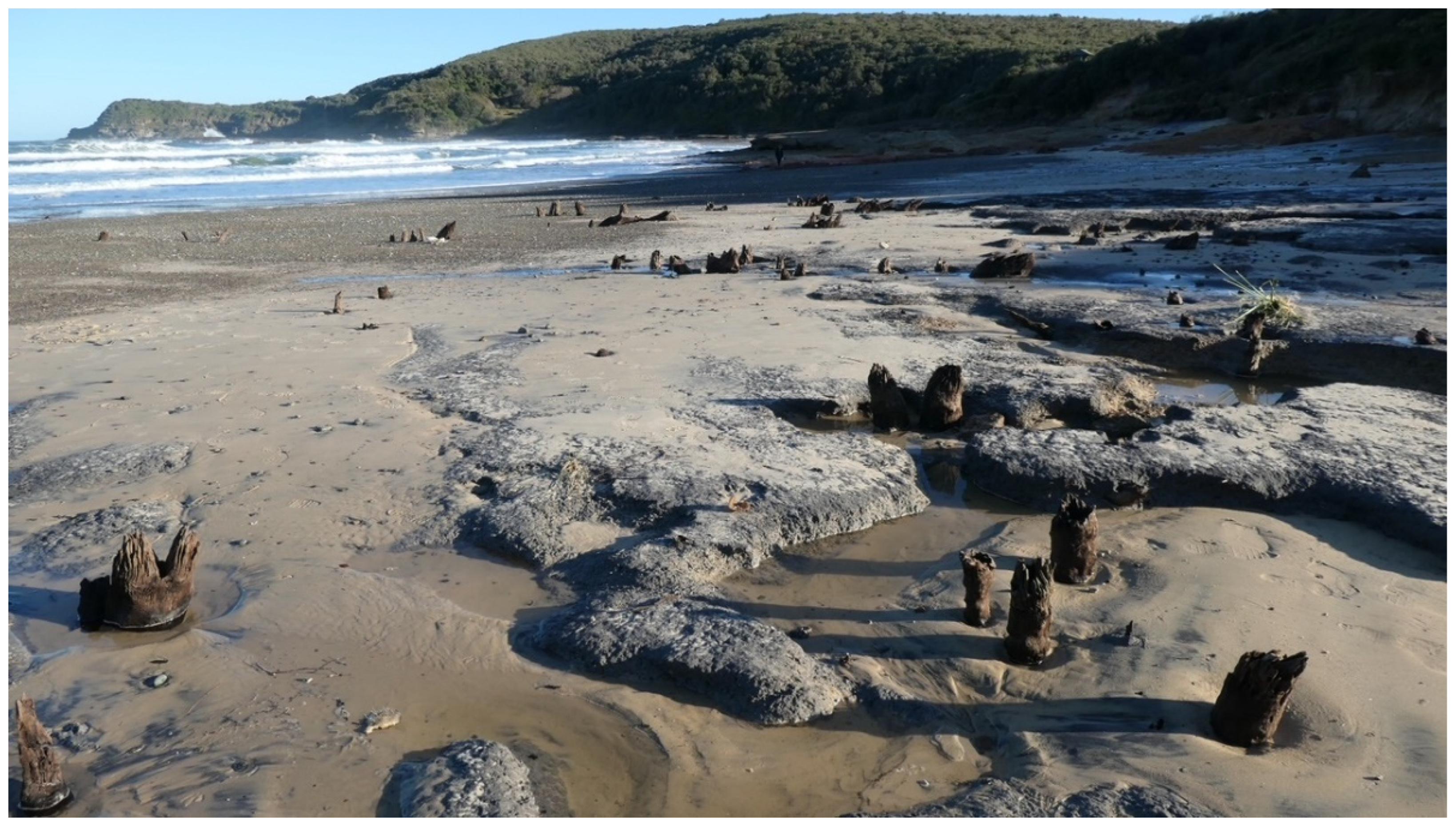

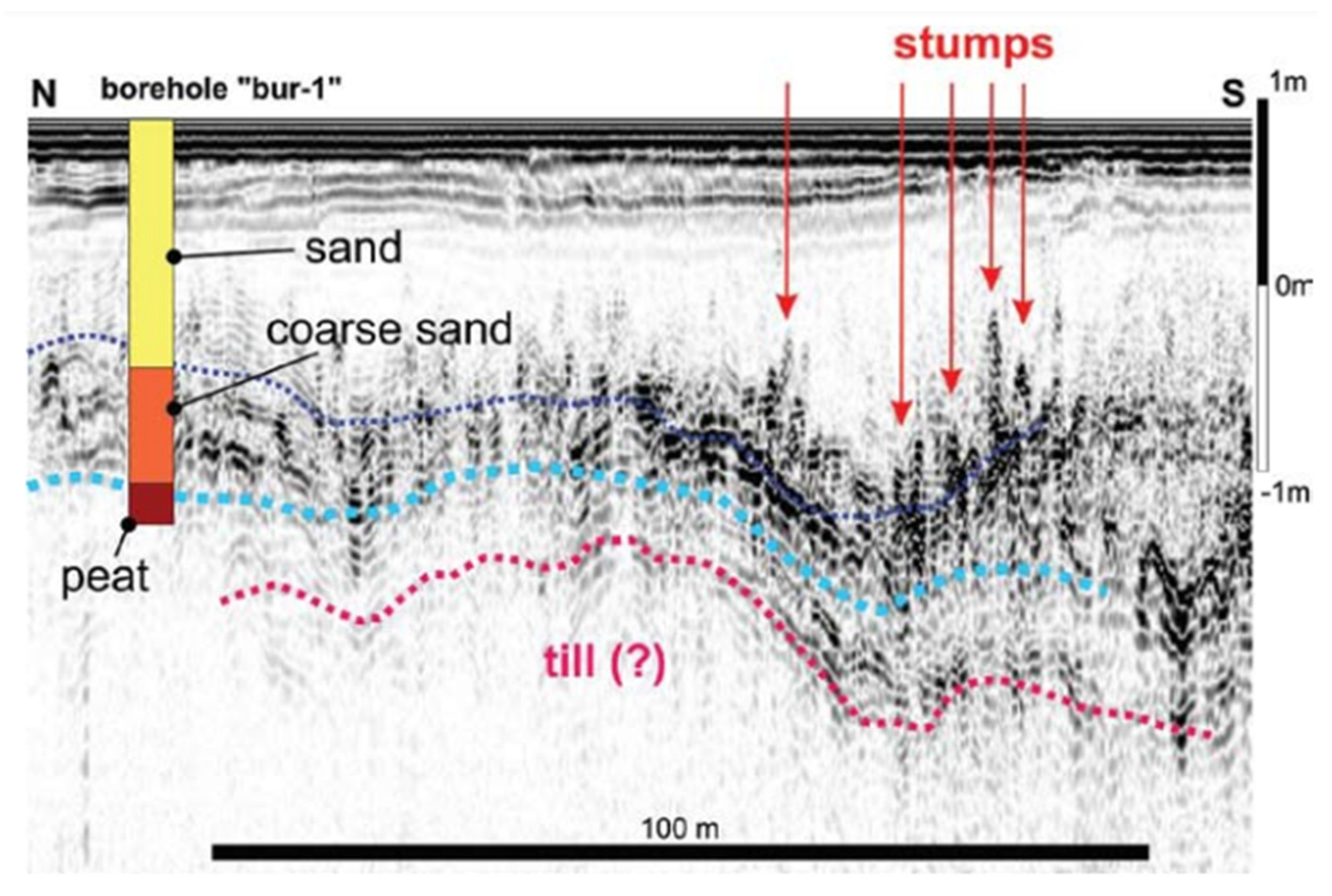
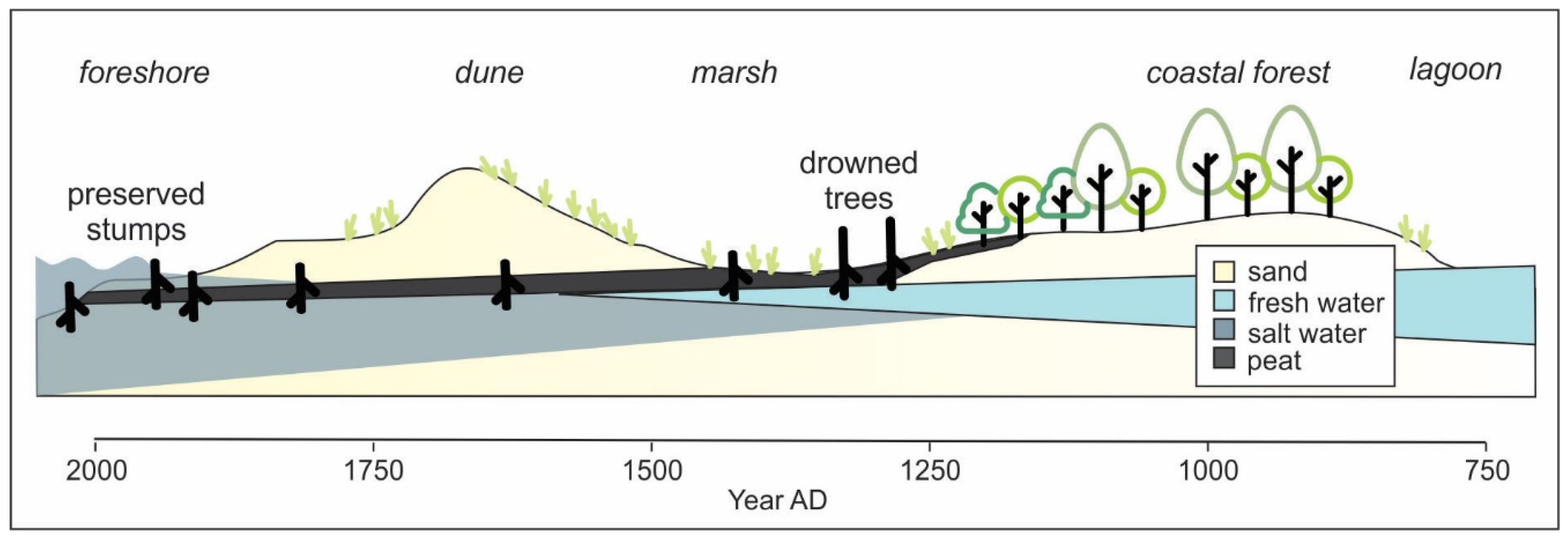
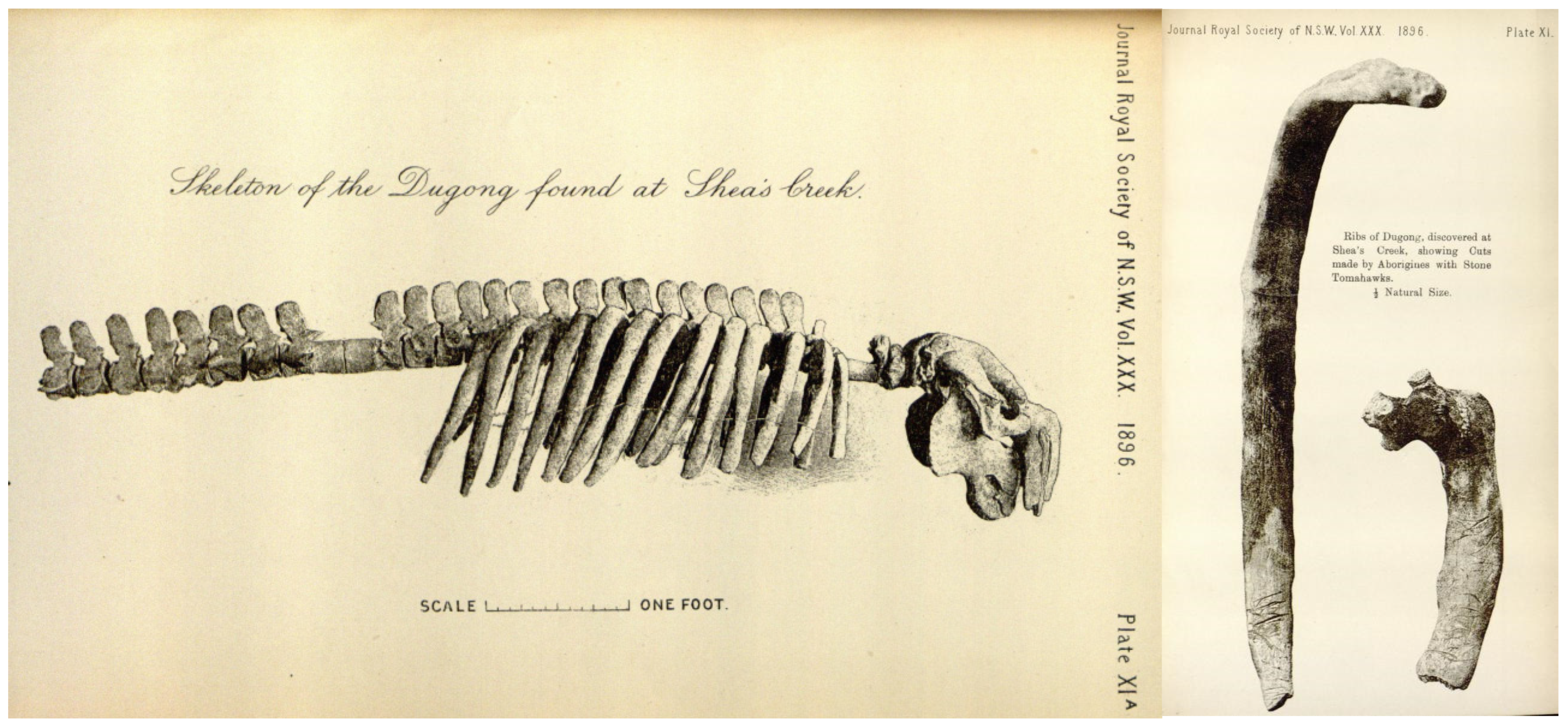

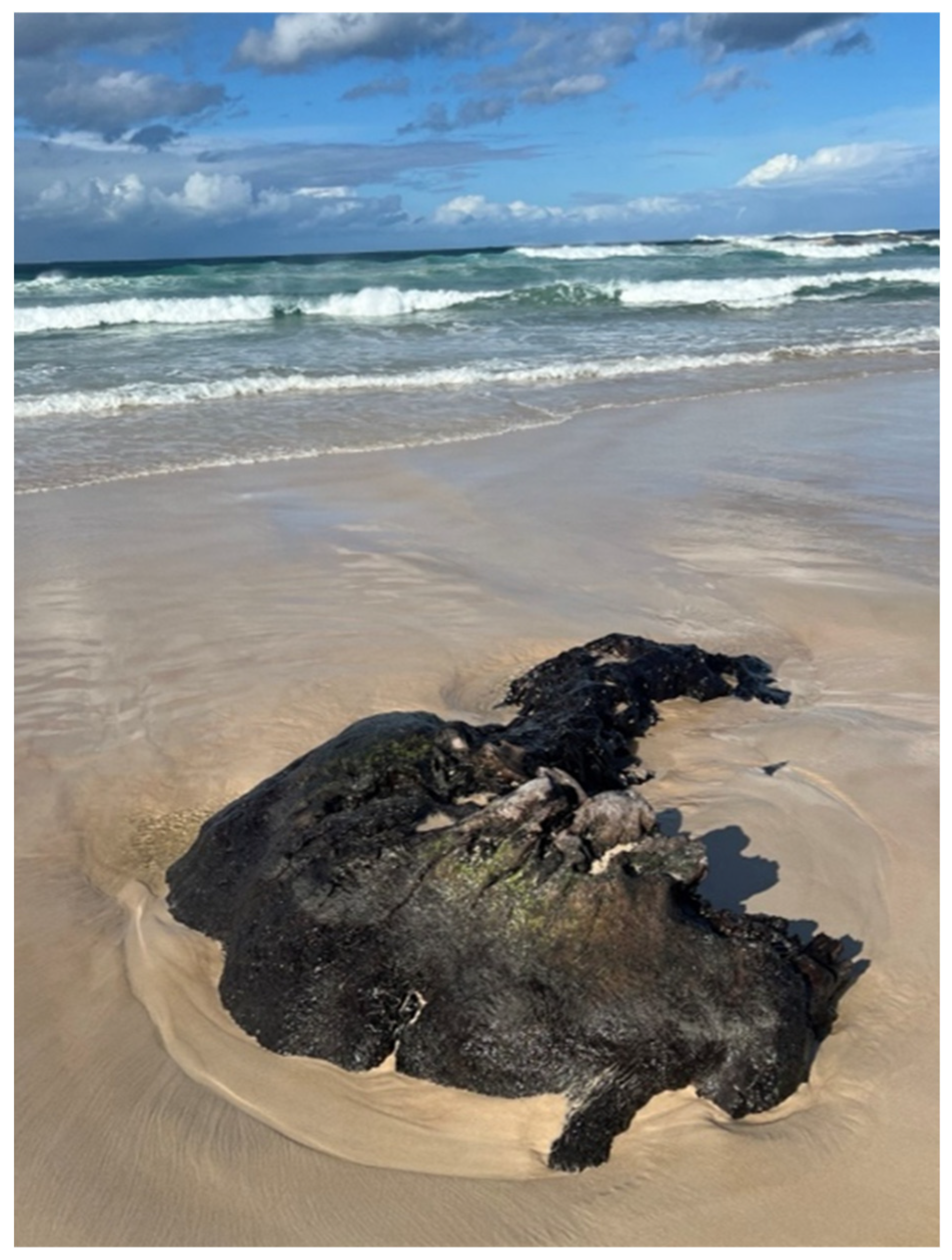
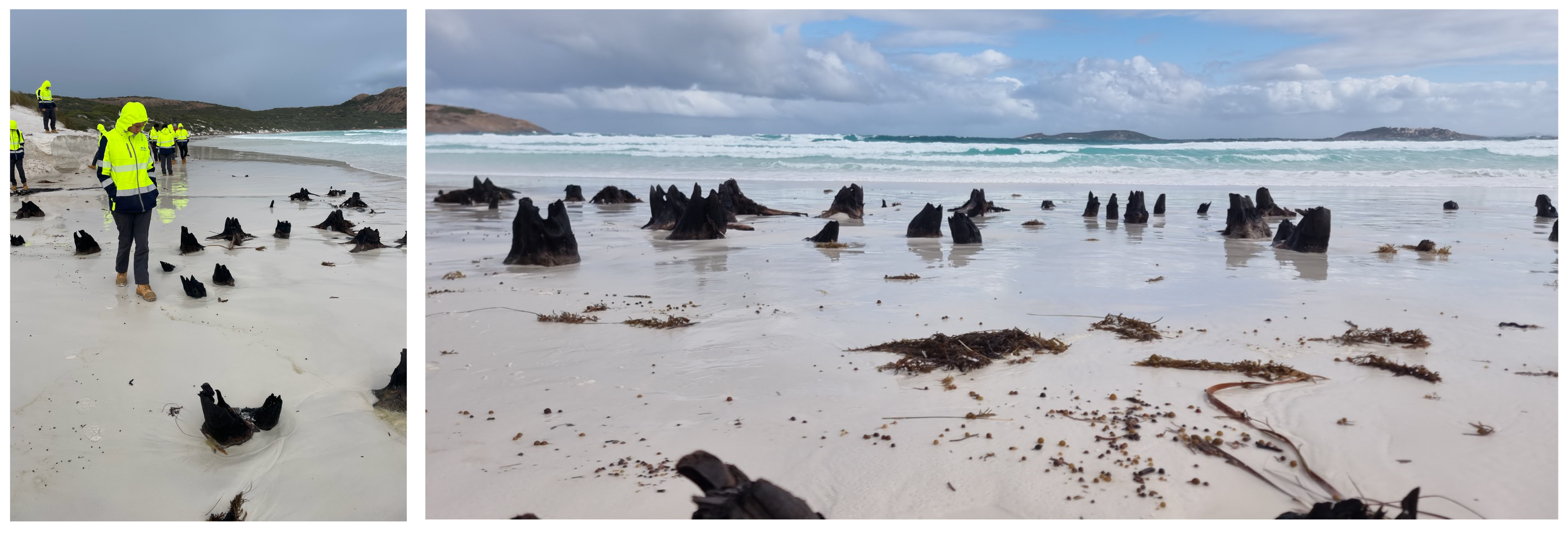
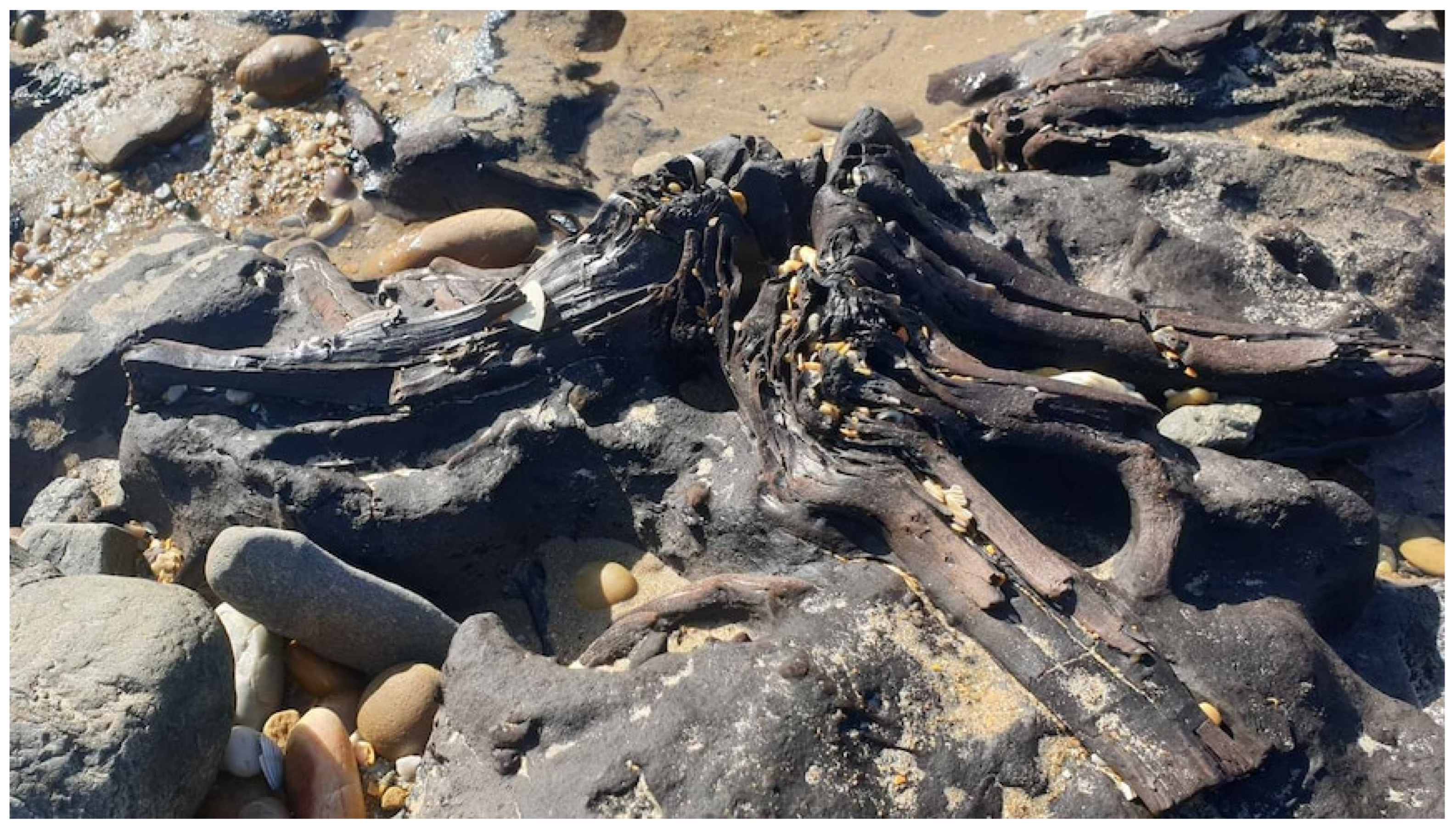
Disclaimer/Publisher’s Note: The statements, opinions and data contained in all publications are solely those of the individual author(s) and contributor(s) and not of MDPI and/or the editor(s). MDPI and/or the editor(s) disclaim responsibility for any injury to people or property resulting from any ideas, methods, instructions or products referred to in the content. |
© 2025 by the authors. Licensee MDPI, Basel, Switzerland. This article is an open access article distributed under the terms and conditions of the Creative Commons Attribution (CC BY) license (https://creativecommons.org/licenses/by/4.0/).
Share and Cite
Ward, I.; Guilfoyle, D.R.; Reynolds, D. Echoes of the Past: Drowned Forests and Indigenous Cultural Connections in Inundated Coastal Landscape. Heritage 2025, 8, 256. https://doi.org/10.3390/heritage8070256
Ward I, Guilfoyle DR, Reynolds D. Echoes of the Past: Drowned Forests and Indigenous Cultural Connections in Inundated Coastal Landscape. Heritage. 2025; 8(7):256. https://doi.org/10.3390/heritage8070256
Chicago/Turabian StyleWard, Ingrid, David R. Guilfoyle, and Doc (Ronald) Reynolds. 2025. "Echoes of the Past: Drowned Forests and Indigenous Cultural Connections in Inundated Coastal Landscape" Heritage 8, no. 7: 256. https://doi.org/10.3390/heritage8070256
APA StyleWard, I., Guilfoyle, D. R., & Reynolds, D. (2025). Echoes of the Past: Drowned Forests and Indigenous Cultural Connections in Inundated Coastal Landscape. Heritage, 8(7), 256. https://doi.org/10.3390/heritage8070256






